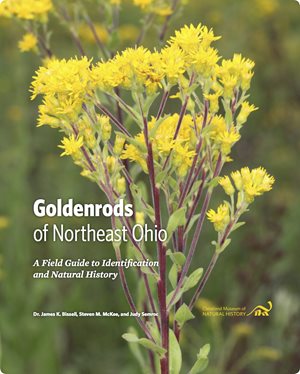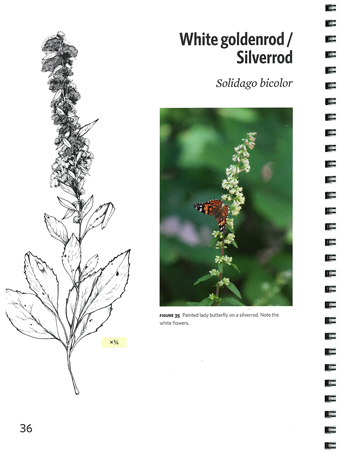
Might this be a golden age for the goldenrod? The native perennial flower has enjoyed a following among those who appreciate its prolific ability to feed many species, from bees to butterflies.
But, it is often mistaken for ragweed and its wild and woolly appearance make it the bane of gardeners. It turns out, goldenrod is a cornerstone of ecosystems across the region.
Jim Bissell, Cleveland Museum of Natural History (CMNH) Curator of Botany, has fielded requests for his, “Goldenrods of the Cleveland Area” for decades. Featuring illustrations by Lee Parkman of 14 species of goldenrod, it was printed on bright yellow copy paper and bound with a single staple.
With interest rising in native plants, CMNH Natural Areas Associate Director
Renee Boronka embarked on a project to revise and update the book five years ago. Geared to nature lovers, gardeners and property owners,
Goldenrods of Northeast Ohio: A Field Guide to Identification and Natural History arrived this month in its new print format.
The book features handsome color photographs of 21 species of goldenrod provided by CMNH Conservation Specialist, Judy Semroc, and hand-inked illustrations produced by Cleveland Institute of Art graduate Lucy Williams. The spiral-bound book has rounded corners and is printed on water resistant (Forest Stewardship Council-certified) paper for ease of use in the field.
It opens on a detailed description of goldenrod. Segments of the flower are described by their shape and function.
Goldenrod are prolific reproducers; they have an impressive range in Northeast Ohio. Dr. Bissell spent decades in the field getting to know goldenrod. A good summary of where he observed each type of goldenrod can be found on pages 2 and 3 in the book. For example, Bog goldenrod is found in the glacial fens of southern Geauga and Medina counties. Stout goldenrod is becoming rare due to deer grazing them from clay-sloped areas throughout the region.
By recent count, 430 species of insects and migrating birds find goldenrod to be a reliable source of nectar, including native bees and Monarch butterflies. The “Glory of Goldenrods” chapter points out how their late summer/early fall blooms provide a constant source of food to aid hibernating bees and migrating birds and butterflies in the winter.
“Many migratory bird species happily stake out goldenrod patches in late summer, preying upon the insects nectaring on the goldenrod flowers. Eventually, as the flowers die back for the season, the plants’ seeds provide a valuable food source for chickadees, finches, juncos, sparrows, and small animals.”

Inside (page 16) is a handy guide for identifying goldenrod species. Amateur naturalists might want to try their hand at the “dichotomous key,” a process of elimination that helps you sort through the physical characteristics, like leaf shapes and flower types, to determine one goldenrod from another.
There’s a fascinating chapter on “galls” — a feature unique to goldenrod. Galls are an ingenious defense mechanism against invasive and parasitic insects, such as the goldenrod gall fly (Eurosta soldaginis). Insects lay eggs in the stem, and when the larvae hatch, they begin to eat the plant for food. The plant responds by speeding up tissue growth in that part of the stem, resulting in a ball-shaped “gall” (sometimes as large as a golf ball) which shelters the larva. Birds like chickadees and woodpeckers avidly extract and consume the insects from certain galls throughout the winter).
The heart of the book is the colorful, information packed two-page spreads of goldenrod species which include photos, pen-and-ink illustrations and facts about the plants’ range (where they are found in Northeast Ohio), height, flower, leaf, and other distinguishing features.
Rounding out the book is a four-page glossary which includes terms that can help you speak knowingly about goldenrods and identify them as the unsung native flowers around the area.
Goldenrods of Northeast Ohio is dedicated to long-time Museum volunteers Barbara Neagoy and Dolores Lad, both of whom worked in the Museum gardens and its native prairie where goldenrods can be found. They also mounted thousands of specimens in the Museum’s Herbarium — which was used extensively in the making of this book.
Funding for this publication was generously provided by the Shaker Lakes Garden Club and contributors to the Cleveland Museum of Natural History’s Botany Department.
HOW TO PURCHASE
Single Copies
Online at Amazon.com
With a check payable to CMNH for $18 (includes tax and shipping) and mail to:
Botany Department
Cleveland Museum of Natural History
1 Wade Oval Drive
Cleveland, OH 44106
Multiple Copies
Contact
Renee Boronka
216-231-4600 x3505
Go back to all blogs